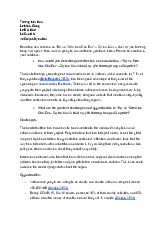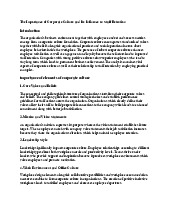


















Preview text:
English for Business Studies Case studies Portfolio Submitted be:
1. Nguyễn Ngọc Trúc Phương – 2192540
2. Huỳnh Yến Nhi – 2174544
3. Trịnh Tường Vi – 22012143
4. Mai Nguyên Vũ – 22011925 Class: 1031 Date: 1/7/2023 Table of Contents
1. Communication................................................................................................................. 1
Question 4: Is communication better these days with all the new technology? How does
technology affect communication positively and negatively?.................................................1
2. International marketing.................................................................................................... 2
Question 1: What are some of the advantages and drawbacks of standardization and
adaptation for international marketing?............................................................................... 2
3. Building relationships........................................................................................................ 4
Question 2: A foreign company is opening a branch in Vietnam. What factors should it
consider in doing business in our country?............................................................................. 4
4. Risk.................................................................................................................................. 5
Question 1: You're planning to do a business (opening a restaurant, a coffee shop, a bookstore,
etc.). Anticipate, evaluate and suggest ways of managing the possible risks you may encounter.
............................................................................................................................................. 5
5. Management styles............................................................................................................ 7
Question 1: Is there one best style of management? Why or why not? Which management
styles do you think get the best out of people?........................................................................ 7
6. Team building................................................................................................................... 8
Question 4: Identify the 5 common causes of team conflicts at work. and suggest some
solutions to these problems as the team leaders/manager as well as team members................8
7. Raising finance.................................................................................................................. 9
Question 1: “A successful business shouldn't need to raise a lot of finance.” Do you
agree/disagree with this statement? Support your argument with relevant reasoning and
evidence............................................................................................................................... 9
8. Customer service............................................................................................................. 12
Question 3: Is good customer service a real competitive advantage? How can a satisfied
customer be the most credible advertising? Justify your answer with evidence (real examples).
........................................................................................................................................... 12
Individual Contribution Evaluation..................................................................................... 17 1. Communication
Question 4: Is communication better these days with all the new
technology? How does technology affect communication positively and negatively?
In today's world, technology has morphed into an absolutely indispensable part of our
everyday existence. It has innovatively modified the way we connect with each other. A vast
array of new digital platforms and devices have appeared, providing us with unparalleled
communication capabilities. Although technology has undoubtedly improved
communication, it has also caused numerous difficulties.
Technology has sped up and simplified communication on one hand, which is worth noting.
By using smartphones and social media, we are able to instantly connect with people located
anywhere in the world. Virtual meetings can be easily conducted, thereby increasing
efficiency and productivity. Additionally, technology has provided substantial benefits for
people with disabilities. Video calls with subtitles and speech-to-text chatbots have improved
communication. Those with vision impairments can communicate effectively through screen- reading software.
Conversely, technology has the potential to exacerbate communication. A major concern
revolves around the impersonal nature of digital communication. Text messages and emails
often exude a frigid and emotionless quality, giving rise to complications. Online
conversations lack the visual cues of body language and tonal inflections, leading to
misunderstandings. Moreover, notifications from our devices serve as incessant distractions,
making it arduous to focus on meaningful dialogues. At times, individuals depend
excessively on digital communication and overlook the importance of in-person interactions.
Although in-person conversations allow for more effective expression, this option is not
always chosen. Additionally, technology can bring problems such as cybercrime and
cyberbullying, creating distrust among people and exacerbating misunderstandings.
All in all, technology has led to improvements in certain communication aspects while also
generating difficulties in others. It is imperative that we incorporate technology in a way that
improves our ability to connect, rather than detracts from it. We cannot afford to lose our
ability to communicate in person. Considering the impact of technology on our ability to 1
connect as humans and striving to use it in ways that promote genuine connections is of utmost importance.
2. International marketing
Question 1: What are some of the advantages and drawbacks of
standardization and adaptation for international marketing?
Expanding businesses all over the world through international marketing can be really
challenging. One of the biggest issues is finding a way to balance standardization and
adaptation of marketing strategies in different countries and cultures. Standardization means
using the same marketing strategy in all markets, while adaptation means changing the
approach to fit the specific needs of local markets.
Standardization can be really helpful in international marketing because it can reduce costs
and guarantee that products and services are always high quality. Using the same production
and marketing strategies in every market can help companies save money. Having consistent
quality can build brand recognition and make customers feel more comfortable, which can
lead to more loyalty. Modification, on the other hand, entails creating marketing strategies,
products, and amenities to meet the specific needs of regional markets. This may increase the
chances of success. Using images and vocabulary relevant to regional markets, as well as
local social media and websites, can help build connections with customers. Additionally,
marketers can use local contacts to determine market preferences and change their products
and amenities to meet these needs, which can increase sales and profit.
Despite the advantages of modification, it also has its share of disadvantages. Adapting
advertising techniques can be exceedingly pricey because companies may have to prepare
diverse versions of their commodities and run separate advertising campaigns for each
market. Also, adapting to the conduct and favorites of local clients requires a great deal of
investigation, experimentation, and creating advertising techniques.
In conclusion, detecting the precise equilibrium between standardization and modification in
international advertising is exceptionally critical and requires a great deal of proficiency and
cautious consideration. In some markets, it's more suitable to use standardization because it
can diminish expenses, make brand advertising more competent, and guarantee reliable 2
quality. A genuinely outstanding international advertising tactic necessitates a profound
comprehension of the target market, the ability to gather and scrutinize data, and professional
advertising proficiency so that companies can detect the precise equilibrium between
modification and standardization. 3
3. Building relationships
Question 2: A foreign company is opening a branch in Vietnam. What
factors should it consider in doing business in our country?
When a foreign business wants to operate in Vietnam, then that business needs to fully meet
the requirements put in the box to be successful. Enterprises need to be the priority that is
complying with the law. When doing business in Vietnam, especially the country that lives
and works based on the law. Unknown will help companies to grow stronger in the future.
However, by respecting the law, the state will ensure the interests of businesses. For example,
when a business wants to open a house, it must have a permit from a competent authority to
build. In addition, companies must also pay taxes and other regulations that the state requires.
Ignore if there is a dispute later. Just rely on legal documents to resolve the dispute. The next
factor businesses need to understand is culture. The culture here is not only expressed
through historical sites. However, culture also shows the style of conversation with the
opposite person. This is considered quite important when politeness, as well as respect,
passes through age. When businesses understand the culture of communication behavior, it
will help businesses form business relationships. A business environment that understands the
behavior culture will help businesses create many positive values. Building culture and
understanding culture will impact the company's personnel. When culture is applied to
employees, officers of the organization. This is to orient employees with a positive cultural
background. From there, it will motivate employees to help make the company stronger.
Culture is also competitive. It will help businesses have a way of doing business and serving.
It will create an impression and feature when reminding about the business. Corporate culture
is a significant factor in the sustainable development of any business, although each business
will have different cultural elements because, without this culture, businesses will conflict
very quickly. The third factor that businesses need is to understand the market. When a
business intends to do business, it is necessary to determine consumers' familiarity and
buying needs in Vietnam. This analysis will be very good for businesses because it will
benefit both sides of the business to increase profits and satisfy the needs of consumers.
Market analysis also helps businesses understand market trends as well as their competitors'
products in order to improve their products better than those of their competitors. Market
analysis also helps businesses with valuable information to optimize business strategies. It 4
includes factors such as product quality, price, service, and price, especially being able to
correctly predict the potential that can be achieved in the future. From there, the business will
earn high profits. The last factor is the local people. Build relationships with local companies
and local people. This will help businesses create a positive view of them. For example, if a
business manufactures products using local ingredients, the business creates goodwill among
the local people. They will support enthusiastically and give businesses reasonable prices for
their raw materials. Businesses need to harmonize to network the best interests of the business itself. 4. Risk
Question 1: You're planning to do a business (opening a restaurant, a
coffee shop, a bookstore, etc.). Anticipate, evaluate and suggest ways of
managing the possible risks you may encounter.
When a new business begins its journey, it will inevitably face many potential risks it cannot
foresee. It has to avoid these problems that may occur, and businesses need to know how to
anticipate and also grasp and manage risks. Moreover, businesses deal with risks most
thoroughly and effectively. In this section, we choose fashion items. The fashion industry
commonly encounters the risks listed below. The first is strategic risks. Fashion trends are
increasingly innovative, forcing businesses to update fashion trends continuously. This causes
an overload of fashion items. It has overcome this risk, and businesses will create customer
surveys, opinions, and post-purchase evaluations to redefine customer needs. Enterprises will
grasp and try to make both the business side and the customer benefit. On the other hand,
businesses will be creative and bring out the latest trends, and products are only sold in
limited quantities. This will help hit the customer's desire to own.The subsequent risk that
businesses often face is financial risks. To avoid this risk, businesses must establish and
analyze it in detail. However, businesses must also know how to grasp the market, budget and
have provisions. Respond promptly when meeting emergencies. Use intelligent technology
software to keep a close eye on the cash flows and revenue of the business. Businesses should
also buy additional insurance packages to stay ahead. When the business has a problem, the
insurance stands to pay. It will help businesses reduce the burden. The third risk that
businesses often face is legal risk. This risk could be legal violations such as intellectual 5
property rights. When these rights are violated, they can be prosecuted. Usually, copyright
infringement is only acceptable, but it also affects the brand reputation to some extent. Legal
risks are also seen in business relationships. Business partners often include suppliers and
joint venture parties in the business. For example, the risk of the lease of premises.
Consequences cause loss to both sides in terms of time and effort. There should be clear and
transparent terms before signing the contract to overcome this risk. Legal risks are classified
based on different criteria. Based on the impact of risk on business objectives, legal risks are
divided into high risk and low risk. The final risk businesses face is reputational risk.
Reputational risk often occurs when customers, investors, and shareholders react adversely to
the business. Regarding customers, when the customer service of the business is not good, the
business will receive negative feedback from customers. They can spread rumors about the
business's bad points, causing the business's reputation to decrease. To solve this
consequence, businesses need to focus and grasp the problem quickly so that it can be solved
quickly and thoroughly. Businesses should continuously monitor and solve temporary
adverse problems. Let businesses avoid unnecessary scandals. In conclusion, When a
business enterprise quickly faces risks, but the most important thing is that the company has
solutions, and predicts risks, then the company will be vital. 6 5. Management styles
Question 1: Is there one best style of management? Why or why not?
Which management styles do you think get the best out of people?
No management style is better than another, simply because they are different and can be
used in different situations. A good manager will know how to balance the aspirations of the
company and the wishes of the subordinates. If a manager is too aggressive with employees,
subordinates will not be fully committed to the job and will not complete the work as the
manager wants. A manager who understands his employees and is willing to share with them
can make employees sympathize and trust the manager more, they will be more comfortable
when working and devote themselves to their work. assigned. On the other hand, if a manager
is too passive or too incompetent, the manager will be looked down upon by the employees
and the superiors treat a manager inappropriately, which will lead to the manager having to quit. or fired.
The key point of a manager for a business is to find the key to ensure there is a balance of
business and employees. The closer a manager comes to achieving that balance, the better the
manager will become. Surely there will never be a thing to keep that balance forever, but just
knowing how to control, solve problems quickly and stably is very successful for a good manager.
Communication skills are one of the most important leadership style competencies and can
connect people in the fastest way. This is a two-way street between management and
employees as it promotes employee morale, engagement, productivity and satisfaction. This
way, the manager can not only keep employees updated on what needs to be done, but also
listen to their ideas, views and feedback. Managers should create groups between themselves
and employees to give them the opportunity to come and talk to the manager to ensure that
the manager is always available and open, creating a sense of closeness in the attitude.
communication level. This will lead to a positive impact on the business as employees feel
involved in the company's business and activities, which will motivate them to achieve better results. 7 6. Team building
Question 4: Identify the 5 common causes of team conflicts at work. and
suggest some solutions to these problems as the team leaders/manager as well as team members. Resource conflict.
Every office worker has a personal working corner, with stationery items. However, there are
many colleagues who have a habit of using things without asking permission, which is also a
cause of conflict. This conflict is not very serious, members can resolve by ensuring that no
one touches any personal items on the desk without consent. Relationship conflict.
In a group, there can be many people from many different regions, cultural backgrounds and
educational levels. Therefore, sometimes people will not agree when looking at the same problem.
Cultural differences can appear in many aspects: language, customs, behavior, way of
expressing opinions, etc. Therefore, if I am a leader, I will learn the culture of all members
and individual employees working under their control. In addition to getting to know
employees on their own, another way that does not lose effectiveness is to encourage
employees to learn about each other through regular sharing and networking activities. This is
not only helpful to the employees, but also allows me to observe the behavior of my
subordinates, thereby suggesting appropriate adjustments to help improve teamwork. Conflict when forced.
There have been many times, many conflicts, conflicts and quarrels in the company
stemming from the cause of being forced to do the will of others, unprofessional work. It is
understood as if we step into someone else's "territory", that owner will have power over his
face and force us to do what they want. At that time, you can't stand the way of management,
so conflict occurs. The solution to this problem is that employees and managers need to
negotiate and negotiate with each other voluntarily, cooperate and respect each other to be
able to come up with an agreement between the employee and the boss. Mission Conflict.
A common type of conflict in businesses is the lack of clarity about the responsibilities and
duties of each person. Each person thinks that he is the one who has the right to decide, or
that the work is his responsibility, causing controversy and leading to conflict. To solve this 8



